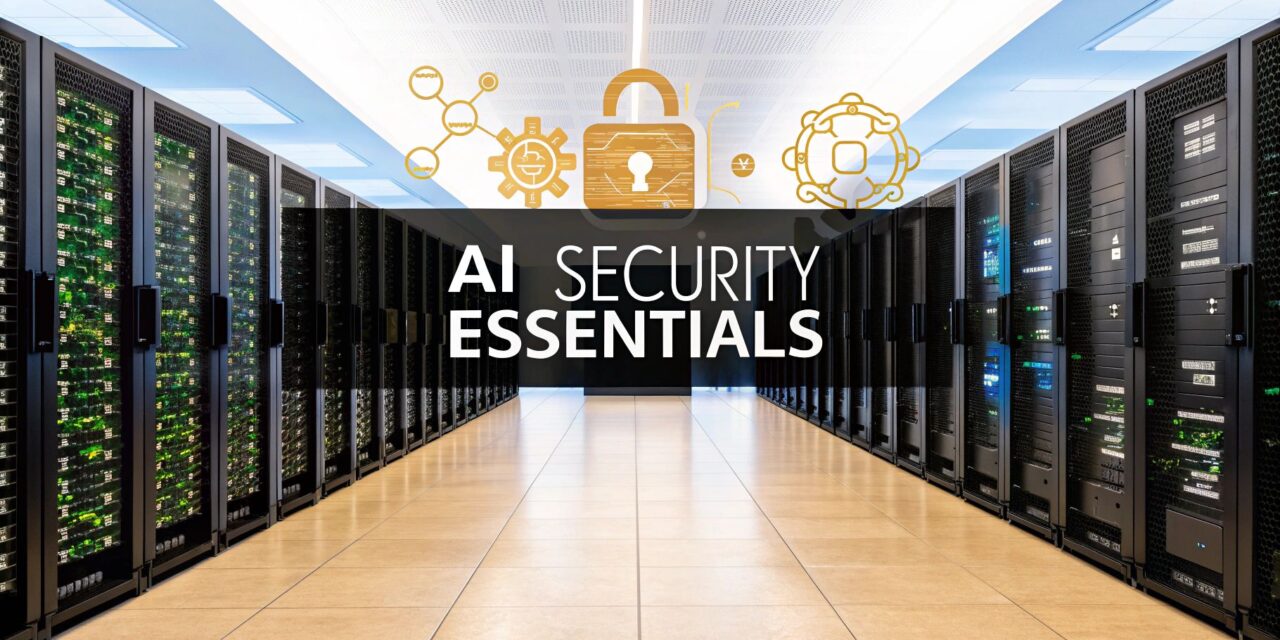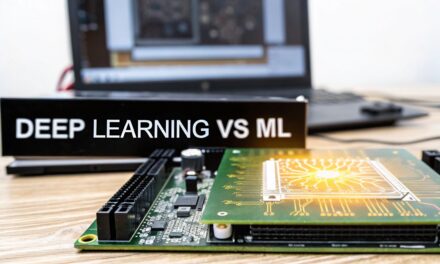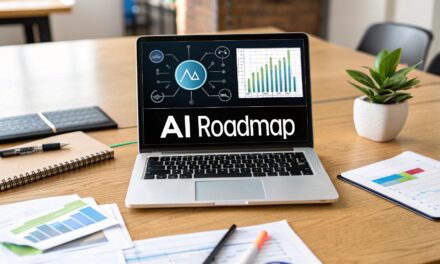Welcome to the world of AI! It's an exciting space, but like any powerful technology, it comes with unique security challenges. Many of us are using AI every day—whether it's asking a chatbot for a recipe or using a smart assistant to set a reminder—often without thinking about what’s happening behind the curtain. The good news is you don’t need to be a cybersecurity guru to understand the basics of keeping these systems safe.
This guide is for everyone: beginners who are just curious, entrepreneurs looking to build with AI, and anyone wanting to use these tools securely. We’ll break down essential AI security best practices into simple, friendly steps, giving you a clear roadmap for building and using AI responsibly. From protecting the data that trains AI models to making sure their answers are safe, we'll cover the core ideas you need to know.
We'll even hear from an expert, Dr. Evelyn Reed, a leading AI security researcher, who notes, "The biggest misconception is that AI security is only for developers. In reality, understanding these principles helps everyone, from consumers to business leaders, make safer choices. Think of it as learning the rules of the road before you start driving a powerful new car."
This article provides a practical, straightforward look at eight critical practices. Think of it as your friendly guide to navigating the AI landscape with confidence. Let's dive into the key strategies that will empower you to protect your AI systems against modern threats and build a foundation of trust.
1. Implement Robust Model Input Validation and Sanitization
Just as you wouldn't let a stranger walk into your house without knowing who they are, you shouldn't let unverified data into your AI model. Input validation and sanitization act as your AI's friendly but firm security guard, checking, filtering, and cleaning all data before it gets processed. This is your first and most important line of defense against a whole host of digital mischief.
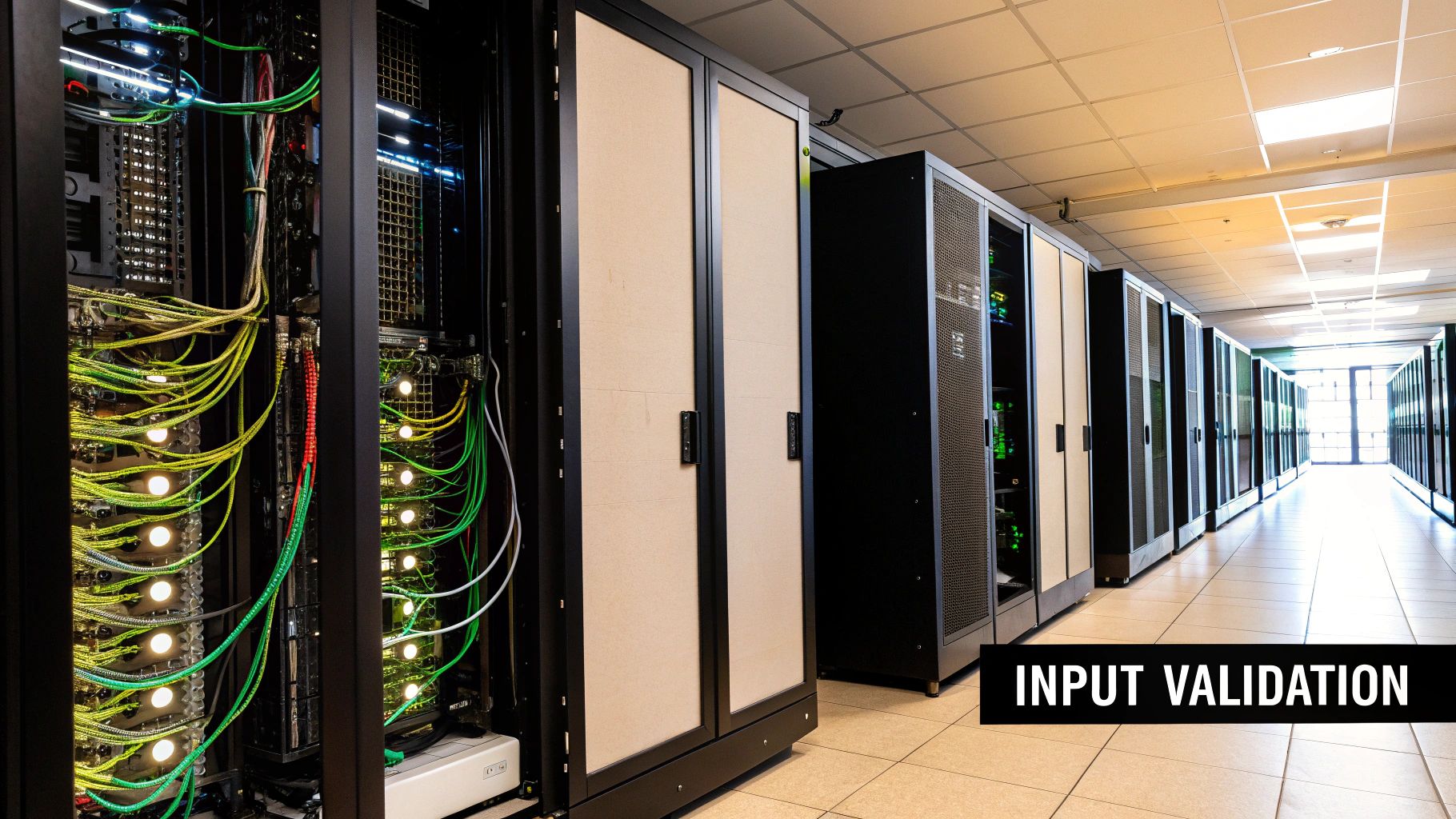
This process involves a few simple checks. For example, if you ask for a user's age, the system should make sure the input is a number, not text, and that it's within a reasonable range (like 1-120). This helps prevent common attacks like "prompt injection," where a tricky user tries to fool the model into ignoring its safety rules by hiding a malicious command in an otherwise innocent-looking question. It also helps stop "data poisoning," where someone intentionally feeds the AI bad information to mess up its training and make it less reliable in the future.
Real-World Examples in Action
Major tech companies use input validation every day as a core part of their AI security best practices. Ever notice how ChatGPT blocks you from asking it to do something harmful? That's sophisticated input filtering at work. Similarly, Microsoft’s Azure AI Content Safety service helps businesses automatically filter out inappropriate user-generated content, protecting their apps from being misused. These aren't just theories; they are real, deployed tools keeping AI safe for millions.
How to Implement It Effectively
To get this right, think in layers, like a digital onion.
- Syntactic Validation: Check the basics. Is the input in the right format? For example, does an email address actually look like an email address?
- Semantic Validation: Go a step deeper. What does the input mean? Is the user trying to trick the AI into revealing sensitive information, even if their words seem innocent?
- Update and Adapt: Bad actors are always coming up with new tricks. Keep your validation rules updated by following the latest findings from security groups like OWASP.
- Monitor and Log: Keep an eye on the inputs that get rejected. This can help you spot patterns and identify if someone is actively trying to attack your system.
For a deeper dive into how these attacks work and why validation is so crucial, check out this video from the AI Security Summit:
2. Establish Comprehensive Model Access Controls and Authentication
If your AI model is a valuable company asset, think of access control as the digital lock and key that protects it. Having strong access controls and authentication means you can be sure that only the right people and systems can interact with your AI, see its sensitive training data, or change how it works. This is all about the simple security principle of "never trust, always verify."
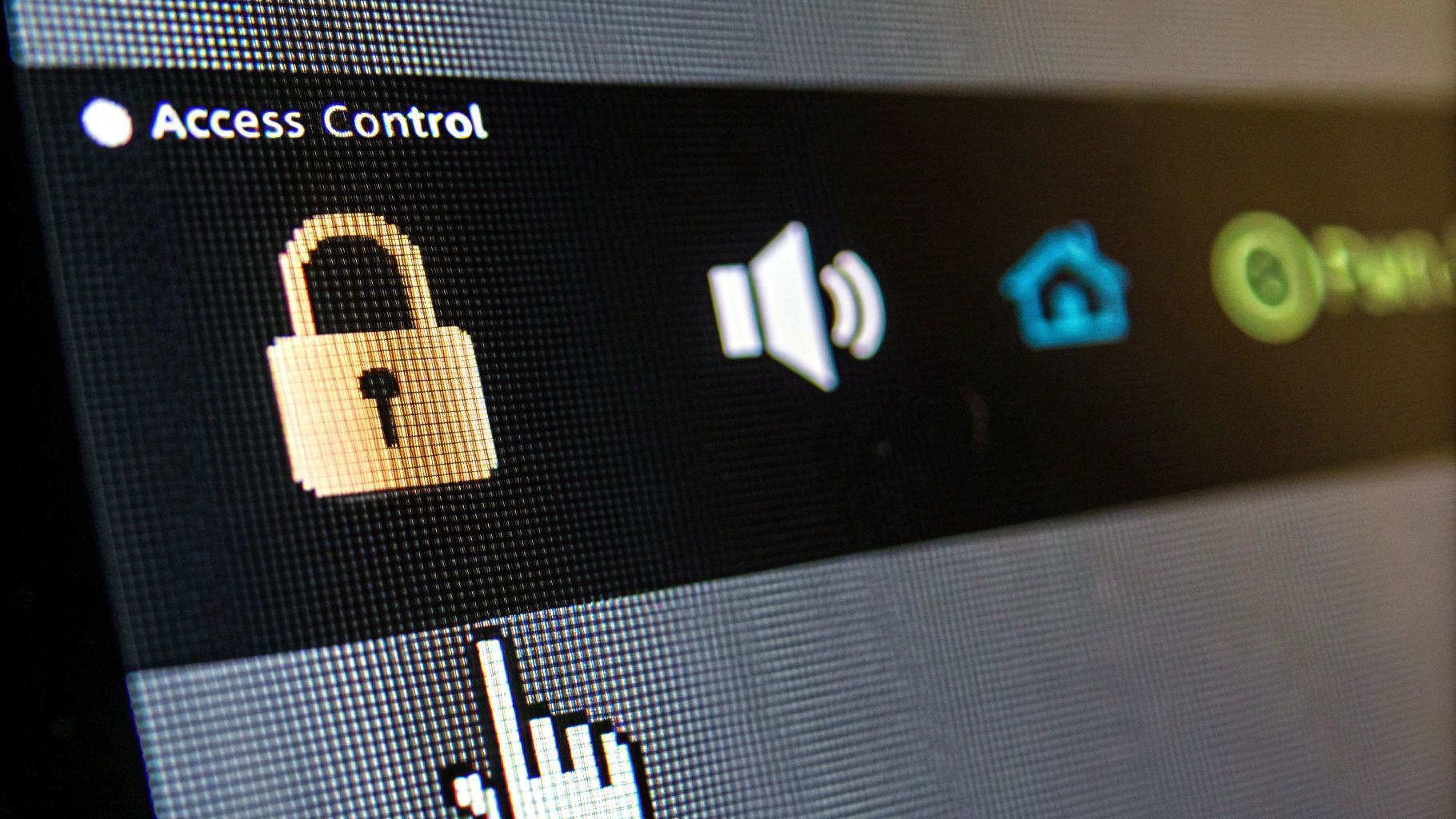
This isn't just about a username and password. It's about giving people specific permissions based on their job. For instance, an engineer who is training the AI needs very different access than a customer support agent who is just using it to answer questions. Strong controls prevent people from meddling with the model, stealing data, or misusing the system, making this a must-have for any serious AI security plan.
Real-World Examples in Action
The big cloud platforms have made this a central part of their services, showing how crucial it is in real-world AI security best practices. For example, Amazon Web Services' SageMaker platform uses something called IAM (Identity and Access Management) to let companies set super-specific permissions for every part of the AI development process. In the same way, Hugging Face, a popular platform for sharing AI models, lets organizations create private collections where only authorized team members can access their secret-sauce models.
How to Implement It Effectively
A multi-layered approach to access control provides the strongest defense.
- Adopt a Zero-Trust Mindset: Don't automatically trust anyone, even if they are inside your network. Always require verification for every request to access the AI system.
- Use Role-Based Access Control (RBAC): Assign permissions based on a person's role (like data scientist, developer, or auditor). This ensures people only have access to what they absolutely need to do their job—a concept called the "principle of least privilege."
- Enforce Multi-Factor Authentication (MFA): We've all used this for our bank accounts. Adding a second step, like a code from your phone, makes it much harder for someone to get in, even if they steal a password.
- Audit and Monitor Continuously: Regularly check who has access to what. Use automated tools to look for strange activity, like someone logging in from an unusual location or at 3 AM, which could signal a security problem.
3. Deploy Continuous Model Monitoring and Anomaly Detection
Launching an AI model without monitoring it is like sending a ship to sea with no one at the helm. Continuous monitoring and anomaly detection act as your model's 24/7 watch crew, constantly observing its behavior, performance, and the data it's processing. This is key for catching subtle problems that might slip past your initial defenses, like the model's performance slowly getting worse or someone trying to trick it with clever attacks.

This involves tracking important metrics in real-time to spot when something looks… off. By first figuring out what "normal" looks like, automated systems can instantly flag unusual patterns, like a sudden drop in accuracy or a weird spike in bizarre user questions. This allows you to jump on a potential security issue or performance problem quickly, long before it becomes a big deal for your users. As AI expert Chip Huyen often says, monitoring isn't an optional extra; it's a core part of a healthy machine learning system.
Real-World Examples in Action
Top tech companies have woven continuous monitoring into their daily operations, making it a key part of their AI security best practices. For instance, Netflix is always watching its recommendation algorithms to spot anything unusual that might mean its suggestions are getting skewed or manipulated. Similarly, financial companies monitor their fraud detection AIs in real-time. If the model suddenly starts flagging lots of normal transactions as fraud, they know something is wrong and can investigate immediately.
How to Implement It Effectively
To get started with continuous monitoring, focus on building a system that's both comprehensive and responsive.
- Establish a Baseline: Before you launch your AI, measure how it performs on clean, normal data. This becomes your "gold standard" to compare against later.
- Monitor Key Metrics: Don't just track accuracy. Watch for things like "data drift" (are the questions people are asking now different from the ones you trained it on?), response time, and error rates.
- Implement Smart Alerting: Set up an alert system that knows the difference between a small hiccup and a full-blown emergency. A minor issue might just create a log entry, while a critical one should immediately notify an on-call engineer.
- Create Response Plans: Have a clear plan for what to do when an alert goes off. Who is in charge of investigating? What are the steps to fix the problem?
- Leverage Specialized Tools: You don't have to build everything yourself! Consider using platforms like Arize AI or WhyLabs, which are designed specifically for watching over AI models and can get you up and running faster.
4. Implement Secure Model Training and Supply Chain Management
Your AI model is only as secure as its weakest link, and that chain starts long before you deploy it—it goes all the way back to the code, data, and tools you used to build it. Securing your AI supply chain means being careful about every single component. It's about protecting the whole process, from gathering data and training the model to the final launch, to make sure no security holes sneak in along the way.
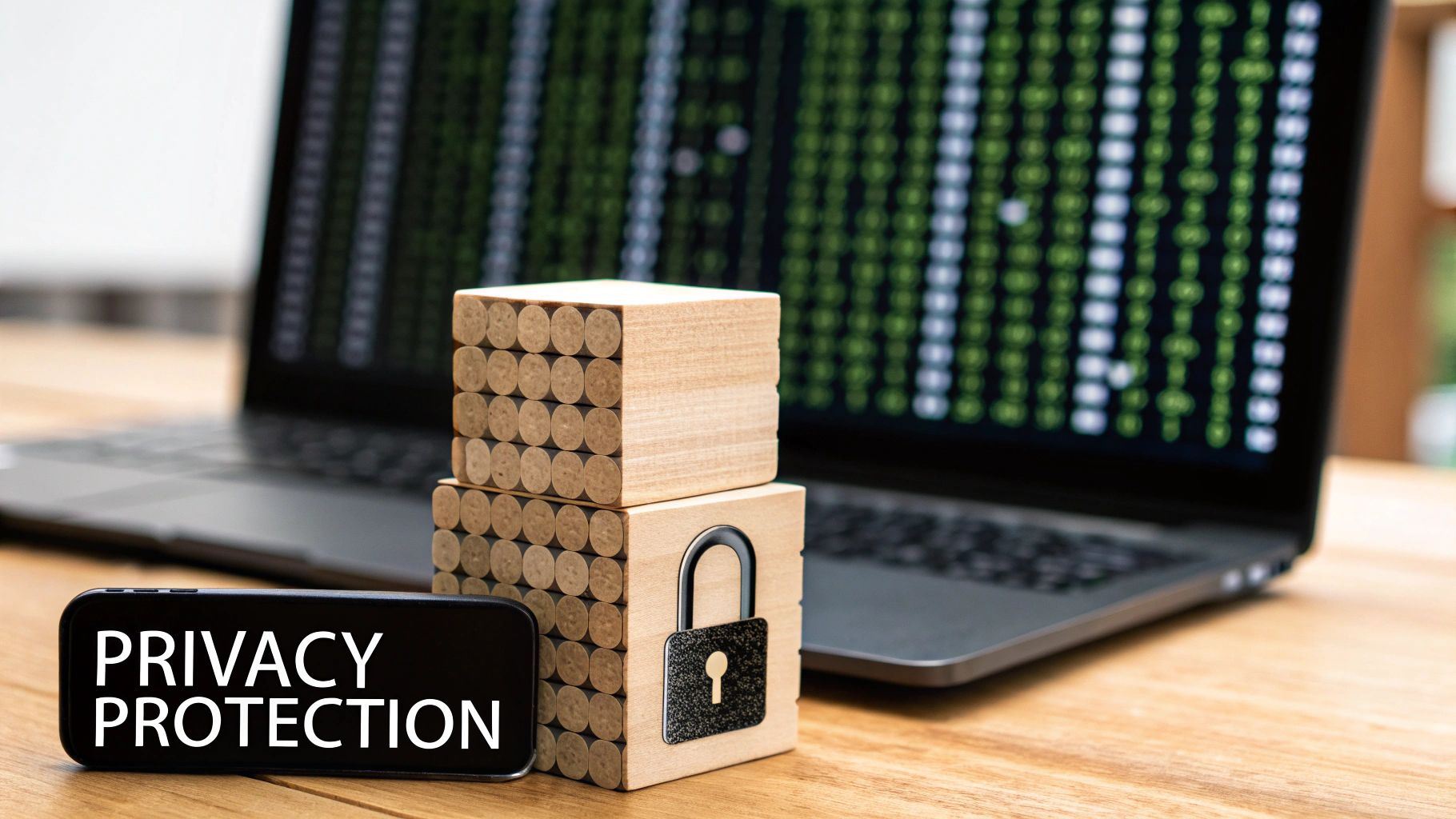
This holistic approach helps protect you from "supply chain attacks." This is where a hacker, instead of attacking you directly, puts a vulnerability into a third-party tool or a pre-trained model that you use. By checking the integrity of your training data, securing the computer where you train your model, and keeping a clear record of every component, you can prove where your model came from and that it hasn't been tampered with. This is a huge step in building trust.
Real-World Examples in Action
Think of the way top tech companies build AI like a secure, high-tech factory line. They've integrated these AI security best practices from day one. Google, for instance, uses a secure pipeline for its TensorFlow models that includes digital signatures to prove they're authentic. Similarly, when Microsoft develops tools like GitHub Copilot, it follows strict protocols to ensure the code and data used for training are clean and vetted.
How to Implement It Effectively
Protecting your AI supply chain requires a layered security strategy that covers people, processes, and technology.
- Isolate and Secure Training: Use tools like Docker to create a clean, isolated "room" for training your AI. This prevents other programs from interfering and ensures you get the same result every time.
- Vet Your Dependencies: Most software today is built using open-source libraries. Use automated tools to scan these libraries for known security holes before you use them.
- Establish Provenance: Keep a "bill of materials" for your AI, just like a list of ingredients for a recipe. It should list every library, dataset, and framework you used.
- Audit and Verify: If you're using a pre-trained model from somewhere else, give it a thorough security check-up before you start adding your own data to it.
For a deeper understanding of the principles behind securing software supply chains, a great resource is the framework developed by the Linux Foundation's OpenSSF, which provides actionable guidance. You can learn more at the OpenSSF Website.
5. Protect Sensitive Data with Privacy-Preserving Techniques
To get smart, AI models need to learn from a lot of data, but sometimes that data contains sensitive personal or business information. Privacy-preserving techniques are your toolkit for building amazing AI without putting that confidential information at risk. These methods allow models to learn from data while making sure that individual pieces of information stay secure and anonymous.
This approach is a cornerstone of modern AI security best practices because it solves the classic tug-of-war between using data and protecting privacy. By using techniques like "differential privacy," which adds a little bit of statistical noise to the data to hide individual details, or "federated learning," where the model learns on people's devices without the raw data ever being sent to a central server, you can build trust and comply with strict privacy laws like GDPR.
Real-World Examples in Action
These aren't just ideas from a research paper; they are being used by the biggest tech companies in the world. For example, Apple uses differential privacy on your iPhone to make your keyboard's autocorrect and emoji suggestions better, all without sending what you type to their servers. In a similar way, Google's Gboard keyboard uses federated learning. The AI learns to predict the next word you'll type by observing patterns across millions of phones, but your personal text messages never leave your device.
How to Implement It Effectively
To successfully integrate privacy into your AI, you need to be proactive.
- Start with Data Minimization: The easiest way to protect sensitive data is to not collect it in the first place. Only gather the information that is absolutely essential for your AI to do its job.
- Implement Privacy by Design: Don't treat privacy as an afterthought. Build these techniques into the very foundation of your AI project right from the start.
- Use Established Libraries: Don't try to invent your own privacy solutions. Use well-tested, open-source libraries like Google’s TensorFlow Privacy or Meta’s Opacus, which have been vetted by security experts.
- Conduct Privacy Impact Assessments: Before you launch your model, think through and write down the potential privacy risks and the steps you've taken to address them.
- Combine Techniques for Strength: For extra protection, you can layer these methods. For example, use federated learning to keep the data on devices, and then apply differential privacy to make the model updates sent from each device even more anonymous.
6. Conduct Regular Adversarial Testing and Red Teaming
If you want to know how strong a castle's walls are, you don't just ask the builder; you hire a team to try and break in. Adversarial testing and "red teaming" apply this same proactive idea to your AI. This practice involves systematically trying to break your own models to find weaknesses before the bad guys do. In short, you play the role of a clever hacker.
This process is more than just a security check; it's a full-on stress test. A "red team" will use creative and unexpected ways to trick, manipulate, or fool the AI. They might use prompt injection to get around its safety rules, try to extract the sensitive data it was trained on, or craft sneaky inputs to make the model say biased or harmful things. This "friendly fire" approach is one of the most effective AI security best practices for finding hidden problems that normal testing would miss.
Real-World Examples in Action
Leading AI labs have made red teaming a standard part of their process. Before releasing GPT-4, OpenAI hired over 50 outside experts to "red team" the model, looking for all sorts of risks, from generating dangerous information to showing societal bias. Similarly, Microsoft has its own AI Red Team that constantly attacks its Azure AI services to make them stronger against real-world threats. It's a clear sign that the best in the business believe you can't build a secure AI without actively trying to defeat it.
How to Implement It Effectively
Integrating adversarial testing requires a structured and continuous approach.
- Establish a Dedicated Team: If you can, create an independent red team that is separate from the developers. This ensures they bring a fresh, unbiased perspective.
- Use a Hybrid Approach: Combine automated tools that can run thousands of simple attacks with creative, manual testing from human experts who can think outside the box.
- Test Across Multiple Vectors: Don't just look for security holes. Test for safety issues, potential privacy leaks, and the possibility that the model could generate unfair or biased answers.
- Document and Learn: Keep a log of all the successful attacks your red team comes up with. Use these findings to build stronger defenses and train your developers.
- Leverage External Expertise: Encourage the wider security community to find flaws by offering a bug bounty program, where you pay rewards to people who find and report vulnerabilities, just like Meta does for its AI systems.
7. Implement Model Output Filtering and Safety Guardrails
While checking what goes into your AI is crucial, you also need a plan for what comes out. Output filtering and safety guardrails act as the final checkpoint, monitoring and controlling the model's responses to prevent it from saying anything harmful, biased, or inappropriate. Think of it as a quality control specialist for your AI's conversations, making sure every response meets your safety standards.
This involves using a set of rules or even other, simpler AI models to scan the generated content for problems like toxic language, hate speech, or just plain wrong information. It's a critical safety net that can catch bad outputs even if a user managed to get a tricky prompt past your input filters. This is one of the most important ai security best practices for protecting both your users and your company's reputation.
Real-World Examples in Action
This practice is used everywhere by leading AI companies. For example, GitHub Copilot has filters to stop it from generating code that accidentally includes secret information like API keys. Another great example is Jasper AI, a writing assistant, which lets businesses set a specific brand voice and tone. The tool then filters its own outputs to make sure they sound right and stay on-message. Anthropic even pioneered an approach called "Constitutional AI," where its model, Claude, is trained to check its own answers against a set of safety principles.
How to Implement It Effectively
A multi-faceted approach to output safety ensures comprehensive protection.
- Implement Graduated Filtering: Not all bad outputs are equal. You might give a soft warning for a minor issue but completely block a response that contains a severe violation.
- Use Ensemble Methods: Don't rely on just one method. Combine different techniques, like lists of banned keywords and more advanced toxicity-detecting AI models, for more accurate filtering.
- Maintain Allow-Lists: For specific applications, you can create lists of known safe phrases or response templates. This helps reduce the chances of the filter accidentally blocking something harmless.
- Log and Analyze: Keep detailed logs of any outputs that get filtered or blocked. This data is pure gold for understanding new threats and improving your safety guardrails over time.
- Provide Clear User Feedback: When you block a response, tell the user why (in a general sense). This helps build trust and teaches them how to use the tool properly.
8. Maintain Comprehensive AI Governance and Documentation
If your AI model is a high-performance car, then governance and documentation are its owner's manual, registration, and maintenance log all rolled into one. Without them, you have a powerful but unaccountable machine. AI governance is about setting the rules of the road for your AI systems—defining policies, ethical guidelines, and risk management plans to make sure they operate safely, responsibly, and legally.
This practice means creating clear and easy-to-find documentation for every stage of the AI's life. This includes "model cards" that explain what a model can (and can't) do, "datasheets" that describe the data it was trained on, and clear plans for what to do when things go wrong. Good governance makes things transparent for everyone involved, ensures someone is accountable, and creates a clear way to manage risks, making it an essential part of your AI security best practices.
Real-World Examples in Action
Pioneered by researchers like Timnit Gebru and Margaret Mitchell, the idea of "Model Cards" has been widely adopted by companies like Google to provide standardized, transparent reports on how their models work. Similarly, Microsoft’s Responsible AI Standard and IBM's AI FactSheets require their teams to create thorough documentation and follow governance rules. These frameworks ensure that as models are developed, their purpose, limitations, and potential biases are clearly understood and written down.
How to Implement It Effectively
Bringing robust governance to life requires a structured, organization-wide commitment.
- Establish a Governance Committee: Create a team with people from different departments—like legal, security, ethics, and engineering—to oversee your AI policies.
- Use Standardized Templates: Create easy-to-use templates for documents like model cards and risk assessments. This ensures consistency and makes the documentation process less of a chore.
- Integrate into Workflows: Make documentation a required part of your development process, just like writing code. It should be reviewed and updated regularly.
- Assign Clear Roles: Be clear about who is responsible for creating, approving, and maintaining the documentation for each AI system.
- Conduct Regular Audits: Periodically check your AI systems to make sure they are following your governance rules, and update your documentation to reflect any changes or new risks you find.
AI Security Best Practices Comparison Matrix
| Practice | Implementation Complexity 🔄 | Resource Requirements ⚡ | Expected Outcomes 📊 | Ideal Use Cases 💡 | Key Advantages ⭐ |
|---|---|---|---|---|---|
| Implement Robust Model Input Validation and Sanitization | High: multilayer, continuous updates needed | High: computational overhead, latency impact | Prevents injection/jailbreaking, reduces poisoning/adversarial risks | AI systems exposed to public or varied user inputs | Multi-layer defense, improves system stability |
| Establish Comprehensive Model Access Controls and Authentication | Moderate to High: complex across distributed systems | Moderate: ongoing management effort | Prevents unauthorized access, supports compliance and audit trails | Systems requiring strict data/model access control | Strong insider threat mitigation, accountability via logs |
| Deploy Continuous Model Monitoring and Anomaly Detection | High: baseline setting, tuning, skilled personnel | High: storage and compute for data analysis | Early detection of attacks, model drift, performance issues | Production AI with live user interaction | Proactive security, visibility into deployed model behavior |
| Implement Secure Model Training and Supply Chain Management | High: tooling, infrastructure, vigilance | Moderate to High: secure environments, scanning | Ensures model integrity, prevents backdoors, supports audits | Organizations with sensitive/trusted AI development pipelines | Provenance tracking, incident response, supply chain integrity |
| Protect Sensitive Data with Privacy-Preserving Techniques | High: specialized expertise, balancing privacy-utility | High: computation-intensive (esp. encryption) | Protects user privacy, regulatory compliance, enables collaboration | AI using sensitive or regulated data | User trust, regulatory alignment, enhanced data protection |
| Conduct Regular Adversarial Testing and Red Teaming | High: skilled team, time-consuming, continuous | High: expert resources, testing environments | Identifies vulnerabilities pre-deployment, realistic security assessment | Security-critical AI systems, regulated environments | Drives continuous improvement, regulatory risk demonstration |
| Implement Model Output Filtering and Safety Guardrails | Moderate: tuning and maintenance ongoing | Moderate: adds latency, processing | Blocks harmful/inappropriate outputs, reduces liability risks | User-facing AI generating open-ended content | Additional defense layer, adaptable without retraining |
| Maintain Comprehensive AI Governance and Documentation | Moderate: cross-team coordination required | Moderate: documentation and audit effort | Accountability, compliance, stakeholder trust | All organizations deploying AI, especially regulated sectors | Structured risk management, transparency, continuity |
Putting It All Together: Your Next Steps in AI Security
We've explored a whole range of essential strategies, from checking inputs and securing your data to constantly monitoring your AI and even trying to hack it yourself. The journey through these AI security best practices shows us one crucial thing: securing AI isn't a one-and-done task or a single piece of software you can install. It’s a living, ongoing discipline that requires us to think differently about how we build, deploy, and use these amazing tools.
The main takeaway is that being proactive is the only real defense. Waiting for your AI to be misused or for a data leak to happen just isn't an option. Instead, security needs to be part of the AI's DNA, from the very first idea all the way through its entire life in the real world. This means always being vigilant, always learning, and making sure everyone works together.
Your Action Plan for Stronger AI Security
Feeling a bit overwhelmed? Don't be. The goal isn't to do all of this overnight. The key is to start smart and build from there. As AI security expert Dr. Anya Sharma advises, "The most significant security improvements often come from addressing the most immediate and relevant risks first. Prioritize, implement, and then iterate."
Here’s a simple, actionable plan to get you started:
- For Individual Users & Enthusiasts: Begin with the basics. Focus on Model Input Validation (Item 1) when you interact with AI. Think critically about what you share with public chatbots. A good rule of thumb is: don't type anything into an AI that you wouldn't be comfortable putting on a public billboard.
- For Developers & Small Teams: Your first priority should be the foundation. Focus on Secure Model Training and Supply Chain Management (Item 4) to make sure what you're building on is solid. At the same time, set up Robust Model Access Controls (Item 2) to lock things down from the start.
- For Established Businesses: You need to think about scale and accountability. Start by establishing Comprehensive AI Governance and Documentation (Item 8) to create a clear set of rules. From there, roll out Continuous Model Monitoring (Item 3) and schedule regular Adversarial Testing (Item 6) to find and fix problems before they affect your customers.
By adopting these AI security best practices, you're not just protecting your own systems or data; you are helping to build a safer, more trustworthy AI ecosystem for everyone. Each input you check, each dataset you secure, and each model you test builds a stronger foundation for the future of artificial intelligence. The journey begins with a single step, and the steps you take today will define how secure and reliable tomorrow's AI will be.
Ready to take your AI knowledge to the next level? The world of AI security is constantly evolving, and staying informed is your best defense. Join the YourAI2Day community to access in-depth guides, expert analyses, and the latest news on building and using AI responsibly. Visit us at YourAI2Day to continue your learning journey today.

